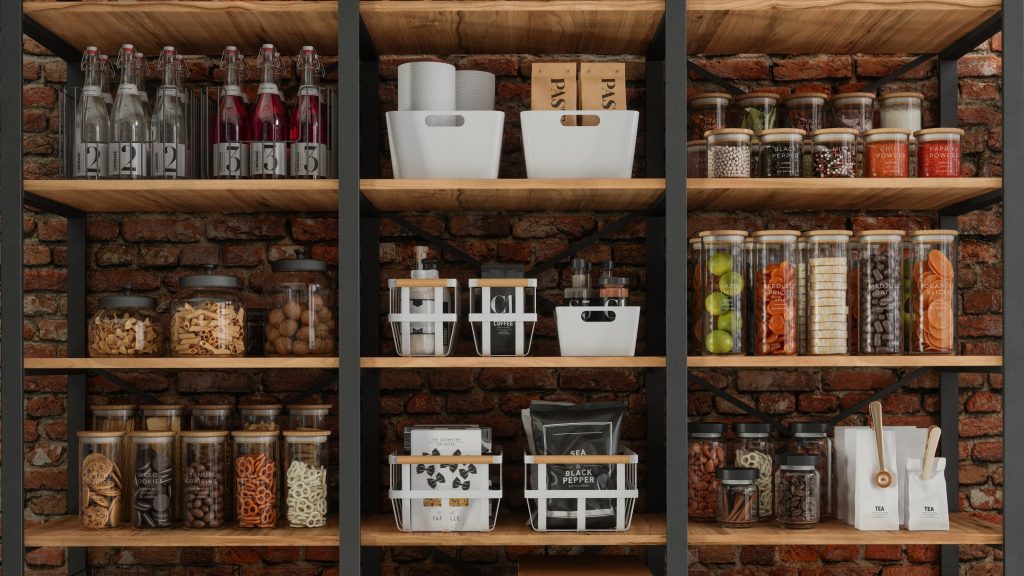Category Organization: How to Group Items to Facilitate Access and Reduce Clutter

Streamlining Your Space
In today’s fast-paced world, organization is more than just a luxury; it’s a necessity. Whether you’re managing a bustling household in Lagos or a lively market stall in Abuja, effective category organization can significantly enhance your productivity and reduce clutter. The system you adopt needs to be practical and adaptable to various areas of your life, allowing you to maintain order amidst the chaos of modern living.
Consider this: disorganization can lead to wasted time, frustration, and—ultimately—a chaotic environment. When you have to sift through piles of clothing, unfiled documents, or unorganized inventory to find what you need, the inefficiency becomes palpable. With the right strategies, you can ensure that every item has its place, making it easier to find what you need when you need it. For example, in Nigeria, many households and businesses can implement organization techniques that reflect their lifestyle and regional characteristics, thereby enhancing daily efficiency.
Why Categorize?
Grouping items effectively not only optimizes space but also improves access. Here are some advantages of proper categorization:
- Faster Retrieval: When items are logically grouped, such as arranging kitchen utensils in drawers by type or stacking books according to genre, you can quickly locate what you’re looking for. For instance, in a busy Lagos kitchen, having all cooking tools in one designated drawer saves vital minutes during meal prep.
- Enhanced Focus: A tidy environment promotes concentration, especially in study settings. Students in Nigerian universities, for example, can benefit from an organized study space that minimizes distractions. Keeping books, notes, and supplies in clear sections helps maintain focus during intense study sessions.
- Reduced Stress: Less clutter cultivates calmness, making daily tasks more manageable. In bustling markets like those in Onitsha, having an effective inventory system can alleviate stress for traders, allowing them to serve customers more efficiently and thus increase sales.
To delve into efficient category organization methods, let’s explore practical techniques tailored for various settings. Whether it’s home, office, or even a small business, the principles remain largely the same. Start with a comprehensive assessment of your current setup. Identify items that can be grouped logically, such as seasonal clothing, important documents, or supplies for your trade. Once you determine how to categorize effectively, invest in storage solutions such as baskets, labeled bins, and shelving that suit your style and space. These simple yet effective tools can revolutionize how you manage your environment.
In conclusion, adopting a methodical approach to organization not only enhances personal and professional productivity but also invites tranquility and clarity into your daily life. Embracing these techniques can set the stage for smoother operations, whether at home or in the marketplace, ultimately leading to a more fulfilling existence.

CHECK OUT: Click here to explore more
Understanding the Fundamentals of Category Organization
Effective category organization begins with recognizing that not all items are created equal, and understanding how to group them can save time and space. By consciously evaluating the purpose and function of each item, you can develop a systematic approach that simplifies access and enhances efficiency. This method transcends various environments, from the home to the workplace, making it an indispensable skill for anyone looking to declutter their life.
First, it’s essential to consider the different types of categories you can create. Categories can be based on functionality, frequency of use, or even size. For instance, in a vibrant household in Ibadan, you might categorize kitchen items based on how frequently they are used, such as daily essentials like plates and utensils, versus rarely used gadgets like specialized blenders. Similarly, in an office environment in Abuja, documents can be grouped by project or departmental relevance, ensuring quick retrieval during business meetings.
Steps to Effective Categorization
To put this into practice, consider the following steps to help you establish an organized system:
- Conduct an Inventory: Start by taking stock of all items in the space you wish to organize. This helps you understand what you have and identify duplicates or items that no longer serve a purpose.
- Define Categories: Based on your inventory, create specific categories for grouping. Clearly defined categories like ‘Books’, ‘Office Supplies’, or ‘Seasonal Clothing’ will help guide your organization process.
- Utilize Storage Solutions: Invest in bins, shelves, and organizers that help you maintain your categories. Labeling each storage container makes it easier for everyone in your home or business to find and return items to their designated places.
- Maintain Flexibility: Remember that organizational needs can change over time. Be open to reassessing and reorganizing categories as necessary, particularly during seasonal changes or when new items are introduced.
- Implement Regular Reviews: Schedule periodic reviews of your organization system to ensure that it continues to meet your needs, eliminating any items that are no longer wanted or needed.
As you implement these steps, keep in mind that the goal is to create a functional and organized space that reflects your lifestyle. In Nigeria, where vibrant markets often feature a myriad of goods, small business owners can particularly benefit from a well-organized inventory system that allows them to serve customers efficiently. An organized stall not only attracts customers but also streamlines the sales process.
In summary, the fundamentals of category organization emphasize clarity, purpose, and adaptability. By understanding what items belong together and creating systems that facilitate access, you are paving the way for a decluttered environment. This approach not only enhances productivity but also enriches your daily life, allowing for a more harmonious coexistence with your space.
| Category | Advantages |
|---|---|
| Digital Organization | Streamlines access to files and information, reducing time spent searching. |
| Physical Items | Maximizes space and enhances the aesthetic of surroundings through functional arrangement. |
| Thematic Grouping | Promotes better understanding and retrieval of similar items, facilitating decision-making. |
| Routine Organization | Encourages consistent maintenance, preventing clutter from accumulating. |
In our fast-paced world, effective category organization emerges as a crucial skill in both personal and professional domains. Categorizing items, whether digital or physical, allows individuals to facilitate access to essentials while minimizing unnecessary clutter. For instance, in the digital space, organizing files into specific categories can dramatically reduce the time it takes to find critical documents, thereby enhancing productivity. On the other hand, effectively grouping physical items not only improves the functionality of spaces but also creates visually appealing environments that resonate with orderliness.
By leveraging thematic grouping, one can enhance memory and retrieval processes, making it easier to locate items quickly. Moreover, establishing a routine for organizing categories promotes accountability and ensures clutter does not accumulate, further contributing to a stress-free lifestyle. Embracing these practices can significantly elevate both personal organization and workplace efficiency, leading readers to a journey of exploration in the often overlooked domain of category organization.
SEE ALSO: Click here to read another article
Advanced Techniques for Category Organization
As you delve deeper into the realm of category organization, you might discover that traditional methods alone may not capture the complexities of your space. Advanced techniques can maximize efficiency and provide an even clearer structure. These strategies can be particularly beneficial in Nigeria, where the hustle and bustle of daily activities often necessitate quick access to important items.
Embrace the 80/20 Rule
The 80/20 rule, originating from the Pareto Principle, suggests that approximately 80% of effects come from 20% of causes. In organizational terms, this means that a small portion of your items is likely responsible for most of your daily needs. Start by analyzing your possessions and identify the 20% of items that you use most frequently. Ensure these items are easily accessible, perhaps near the front of shelves or on the top of stacks, while the remaining 80% can be organized in a less accessible manner. This method not only simplifies your organization but also highlights the importance of prioritization.
Color Code Your Categories
Incorporating color coding into your organization system can significantly enhance visibility and ease of access. Assign specific colors to each category—like using red for urgent documents, blue for office supplies, and green for personal items. This visual strategy can expedite the retrieval process. In Nigerian offices or homes, where time is often of the essence, color coding can save crucial minutes during busy periods. Additionally, for children’s areas, utilizing color-coded bins can teach them about responsibility and organization from a young age.
Digital Tools for Enhanced Organization
In an increasingly digital world, combining physical organization with digital tools can bring about a transformative experience. Apps designed for inventory management can help keep track of items in various categories, allowing you to monitor usage patterns and assess inventory levels effectively. For instance, small-scale business owners in Nigeria can utilize platforms that offer stock management solutions, thus ensuring that they never run out of essential items or get overwhelmed with excess stock. Furthermore, cloud storage solutions can help you categorize and access documents from anywhere, reducing physical clutter while enhancing your productivity.
Simplify with Minimalism
Minimalism focuses on the idea that less is more. By adopting a minimalist mindset, you can significantly reduce clutter and simplify your life. Conduct regular assessments of your items, asking crucial questions: Does this item bring value to my life? Is it necessary? If the answer is no, it might be time to let it go. In Nigerian homes and offices, creating a culture of simplicity can enhance the overall atmosphere, allowing for clearer focus and increased creativity. This principle not only applies to physical items but can extend to digital files, ensuring a smooth operating environment.
Utilize Vertical Space
Many people overlook the space available above eye level. Utilizing vertical space by installing shelves or brackets can effectively expand your storage capacity without occupying additional floor space. In homes or small businesses in Nigeria, this technique is invaluable, especially in densely populated areas where real estate comes at a premium. By strategically placing items in accessible vertical spots, you enhance organization and ensure your space is utilized efficiently.
The journey towards effective category organization is an ongoing process that requires creativity and strategic planning. By employing these advanced techniques, you can create a system that not only facilitates access to your items but also reduces clutter, leading to a more organized and productive lifestyle.
RECOMMENDED: Check out this similar article
Conclusion
In conclusion, mastering the art of category organization is essential for creating an efficient and clutter-free environment. By employing various innovative strategies—such as recognizing the 80/20 rule, implementing color coding, embracing digital tools, and adopting a minimalist approach—you can significantly enhance your ability to access items quickly and maintain order. In the unique context of Nigeria, where bustling lifestyles often lead to chaotic spaces, these advanced techniques become even more invaluable.
Additionally, utilizing vertical space not only maximizes storage in areas where every square meter counts but also promotes a sense of clarity in your surroundings. By consistently evaluating and re-evaluating your organizational systems, you can adapt to changing needs and cultivate a culture of discipline and organization—be it at home, in the office, or within the community.
As Nigeria continues to grow and evolve, so too must our approaches to organization. By focusing on accessibility and intentional grouping of items, you can contribute to a more productive lifestyle and improved well-being. Dive into the world of category organization, discover the techniques that resonate with you, and allow these practices to shape the way you interact with your space for the better. Embrace the challenge, and watch as a more organized life unfolds before you.


